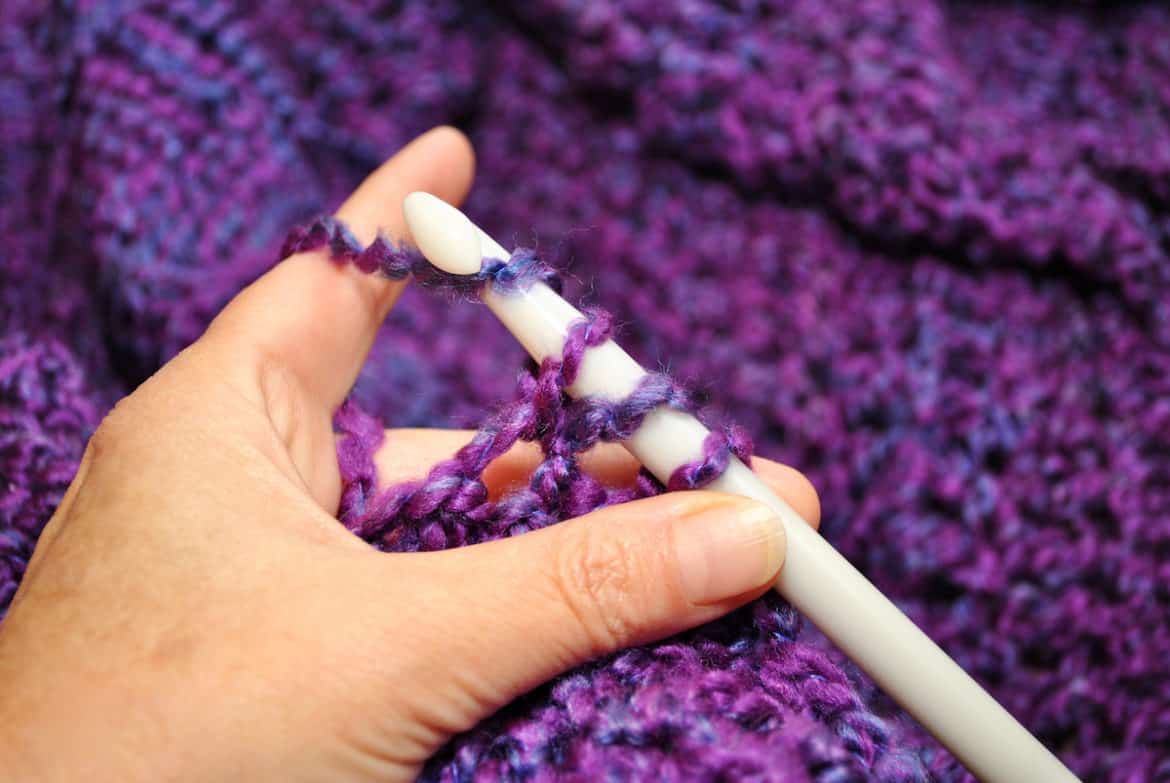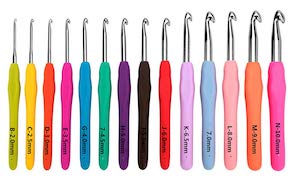With so many crochet hooks to choose from, how do you choose the right one? Well, the size of the hook you use for crocheting depends on the thickness of your yarn.
Don’t worry, we’ll explain what we mean by that and give you all of our best tips for finding the right crochet hook in this article.
So what size crochet hook should you use for blankets? The best size crochet hook for blankets is an H/8 (5mm), made of aluminum. For bulkier blankets, you will want a larger hook. For a regular blanket, medium weight is a good choice. For finer blankets, such as a baby blanket, a smaller hook would be a good choice.
Read on to continue learning more about choosing the best crochet hook for your blanket crocheting needs. We did all the research for you and compiled it into this easy-to-read guide. Enjoy!
A Guide to Crochet Hook Sizes
The sizes of crochet hooks can be a bit confusing. The material used, the brand and where it was made are all determining factors on what the size of the hook is called.
Basically, the size is determined by the diameter of the shaft – the section between the point and the handle. The size of your stitches is determined by the size of the shaft.
In the U.S., hook sizes are denoted by letters. The higher the letter, the larger the hook. Sizes generally vary from B (2.25mm) to Q (16 mm). Heavier yarn requires a larger hook.
These are some of the most common yarn and hook combinations:
- Super-fine yarn – B-1 to E-4 hook (3.5 mm)
- Sport weight yarn – E-4 to 7 hook (4.5 mm)
- Light worsted yarn – 7 to I-9 hook (5 mm to 5.5 mm)
- Worsted weight (a high-quality type of wool yarn) – I-9 to K-10.5 hook (6 mm)
The label on any skein of yarn will tell you the suggested hook size to use and the estimated number of stitches you will get per inch. In some cases, the label goes by stitches per 4 inches because the average block is about 4 inches.
Types of Crochet Hooks
A crochet hook is a tool with a slender handle and a hook on one (or both) ends. The hook is used to create the pattern by pulling strands of yarn through loops you make with your yarn, this creates stitches.
You can create a large variety of stitches from very fine hairpin lace to large squares. For added flair, you can even thread beads or other objects through the stitches.
While crochet hooks are all basically made the same way, there are a few little variations in the way they are shaped and of course, the material used to make the hook. The material and size of the hook have a big impact on how the yarn passes along the hook and how the hook creates the stitches.
The “head” or top part of the hook is either round or pointy. A round head is a good choice when working with yarn that might split or fray.
You’ll want a pointed head when the design you are creating is very dense because the point will pass through previous stitches easier than a round head.
Hooks also may have different “throats,” which is the part just below the top of the hook. The throat can be shaped at an inline or a taper. An in-line hook is sturdy with a rigid decline, which helps hold the yarn snugly onto the shaft.
This is better for beginners since the yarn won’t accidentally slip off as easily. It is also a good choice when working with lighter weight yarn.
A tapered throat is smoother and lets the yarn slip off easily. Experienced crocheters want the yarn to slip off easily because they are accustomed to working rather quickly.
The size, handle, and type of hook can vary. And each type has benefits and drawbacks, such as how easy it is to use, what type of yarn you can use, the price and how it feels in your hand.
Steel Hooks
Steel hooks are generally used for crocheting thread, that is why they are commonly called “thread hooks.”
Steel hooks are ideal for doilies and fine lace trimming you want to incorporate into other projects. These are ideal for making doll clothes or any other small, delicate crocheting projects.
Steel crochet hooks, like these ones on Amazon, are available in numbered sizes, where the larger the number, the smaller the hook.
For example, a size 14 hook is 0.6 mm in diameter and a size 00 has a thickness of 3 mm.
This is usually not a good choice for blankets because you want your blanket to be bulkier and warmer. The only time you might consider this hook is to add creative designs or lace trim to a decorative blanket you don’t plan to use for warmth.
Metal Crochet Hooks
Metal or aluminum crochet hooks are the smoothest crochet hooks available.
With metal crochet hooks, like these ones on Amazon, the yarn glides down the shaft smoothly and slips off the hook without any snagging or fuss.
This makes crocheting quicker and easier. Experienced crocheters prefer this type.
They already have the pattern and motions down pat, so fussing with snags and stuff is too much of a bother.
Beginners aren’t bothered by snags because they are too focused on making every stitch just right. Snags generally only occur with speed, and since a beginner is not very fast, this is not a problem.
However, this doesn’t mean a beginner should not use a metal hook. Don’t be intimidated by the smoothness. You might just find it easier to learn on one of these than any others.
Plastic Crochet Hooks
Plastic hooks are great for beginners, especially children since they can’t get hurt with a plastic head. Metal hooks could pierce their fingers.
That doesn’t mean they are not just as suitable for adults. Anyone can use any hook they like.
If you are more comfortable with a small, lightweight plastic crochet hook (like these), then that is the hook you should use.
The main thing is to be comfortable. If you are not comfortable with your hook, you might be tempted to abandon your project.
Wooden Crochet Hooks
Wooden crochet hooks can be more expensive than their metal or plastic counterparts, however, they are the hooks of choice for many crocheters because of the natural warmth they provide.
Environmentalists are particularly drawn to this type because they are considered better for the environment.
A cheaper choice to standard wooden crochet hooks is the bamboo crochet hook.
This type is just as warm and lightweight as the wooden one, but cheaper because bamboo is less expensive to purchase and manufacture than real wood.
Tunisian Crochet Hooks
Tunisian hooks are longer than regular hooks, and sometimes have a hook on each end. This type of crochet hook is also called a “cro” hook.
In many ways, it is similar to a knitting needle. You keep your stitches on the Tunisian crochet hook, like you do with knitting, as you create the blanket.
Crocheting with a Tunisian hook is also called the Afghan-style of crocheting.
Ergonomic Crochet Hooks
Ergonomic crochet hooks are easier on your hands and fingers.
You can get them all in one piece or as separate handles that you insert regular hooks into for a thicker handle.
Generally, they have large soft handles or shafts you can insert regular hooks into to make using them easier for certain people.
They are specially designed to reduce the strain in your fingers and hands that can occur when gripping a small hook for extended periods. You can also find ergonomic knitting needles.
Many people suffer from aches and pains in their fingers and hands. This can drastically interfere with their love of crocheting. That is where these ergonomic crochets hooks come in.
Hand fatigue or chronic pain resulting from repetitive actions or old injuries is greatly relieved by using this type of hook so you can enjoy your hobby so much longer.
Knook Crochet Hook
This type of crochet hook gives you results similar to that of knitting, but with the ease of crocheting. You can create fabulous stitches that look like knitting, but with just one single crochet hook instead of two knitting needles.
A Knook crochet hook is a long crochet hook with a hole (like the eye of a needle) on one end and a hook on the other.
You simply thread a piece of yarn through the hole in the Knook needle and proceed according to the directions on your pattern.
Crocheting a blanket with a Knook crochet hook in a few simple steps:
- Thread the yarn or cord through the hole (eye) and then pull about 6 inches (15 cm) of it all the way through
- Tie the cord onto the hook with a slip knot
- Make a foundation of chain stitches which will become your base
- Pick up each of the stitches
- Slide the stitches onto the cord
Once you have all of the foundational stitches in place on the cord, begin to hook the yarn through the main body with a knit stitch or a purl stitch.
Continue in this way or follow your own special pattern until you have the blanket to your desired size.







